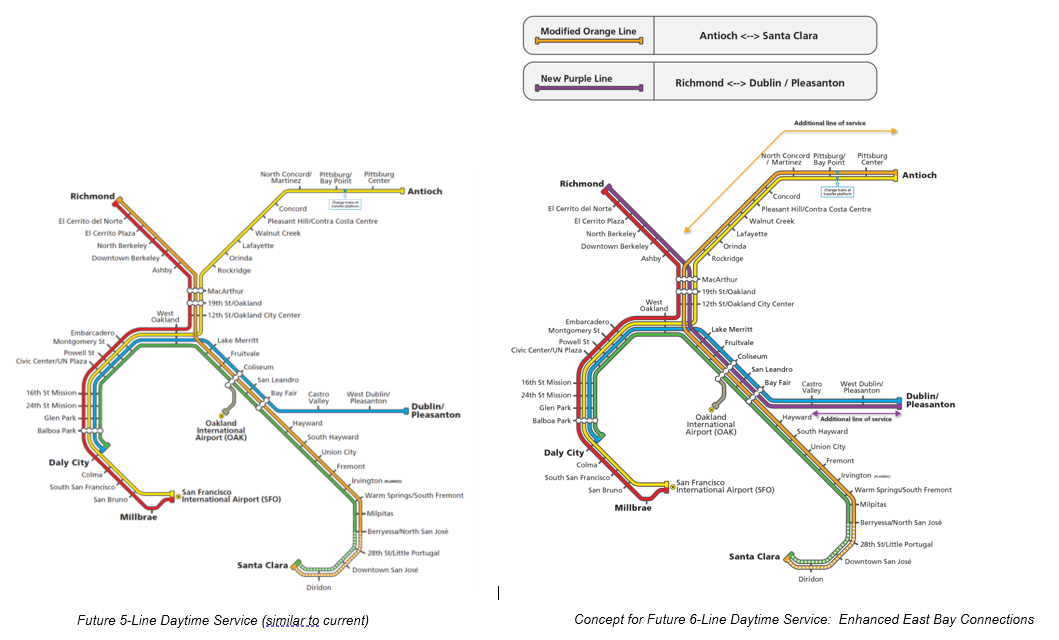Take the BART Metro 2030 survey on two future service concepts
BART has developed two new service concepts for the future and is soliciting public feedback through this short survey. As the Bay Area’s transportation needs change over time, we appreciate the public’s thoughts on these two concepts. Participants who complete our short survey by 11/23/2022 can enter to win a $100 Clipper card.
The following section provides a brief summary of the two future concepts being explored, noting that these concepts are still ideas and additional analysis, public engagement, and funding would be required before either of these concepts could become real service plans. BART is seeking to understand if these service concepts could better serve post-pandemic ridership patterns, including travel during the off-peak period.
1. Enhanced East Bay Connections
The map on the left below shows service in the future (after new stations in San Jose and Santa Clara open) if BART continues to run five lines of service every day until 9 pm. The map on the right shows the Enhanced East Bay Connections concept that could better serve daytime trips outside of the traditional San Francisco commute by adding more direct East Bay connections.
- Pending funding availability, the map on the right below shows a new daytime (every day until 9pm) service concept for the future after new stations in San Jose and Santa Clara open-- adding a 6th line (Purple Line on the second map) and modifying the Orange Line. The new Purple Line would run from Richmond to Dublin/Pleasanton, and the modified Orange Line would run from Antioch to Santa Clara.
- This concept would serve all stations by at least two lines and increase service between stations in Oakland and San Leandro from 3 to 4 lines
- However, there would be no direct Richmond to Santa Clara train in this concept.
2. Enhanced Evening Core Services:
The map on the left below shows service in the future (after new stations in San Jose and Santa Clara open) if BART continues to run three lines of service every day from 9 pm to midnight. The map on the right shows an Enhanced Evening Core Services concept that could better serve evening trips by providing additional service in the system’s core, where ridership is higher, on top of BART’s existing three-line evening service.
- Pending funding availability, the map on the right shows a new evening service concept for the future -– additional service in the core, or center, of the BART system, where ridership is higher. After 9 pm, BART would run its usual evening service on three (Yellow, Orange, and Blue) lines, but would add service on a portion of the Red Line (Richmond to Daly City) and a portion of the Green Line (Bay Fair to Daly City).

About the BART Metro 2030 and Beyond Study
Travel patterns are changing, and it is essential for BART to be responsive to these trends and to continuously update our plans for short-term, mid-term, and long-term improvements. The BART Metro 2030 and Beyond study will evaluate future service ideas that account for exciting upgrades that are currently underway or planned at BART. The study will consider possible new train service patterns and routes that could potentially provide more options for riders. The study will develop a list of capital projects that are necessary to improve operational efficiency and deliver the service enhancements prioritized by our riders in the survey and study outreach. This could be new train car storage facilities or bypass tracks that would enable greater flexibility that doesn’t exist today. These projects would leverage large scale investments currently advancing and will be implemented by 2030 such as expanding our fleet with new rail cars, upgrading infrastructure to expand transbay capacity, and bringing on a state-of-the-art Communications Based Train Control system that will allow us to run trains closer together and more frequently.
The study will also complement our Link21 Program -- a longer term planning effort to add a second transbay rail crossing and other projects to improve transit options across the 21-county mega region. The BART Metro 2030 and Beyond Study will look at projects and improvements that can be implemented before Link21 to better serve our riders and attract new riders.
By better matching BART service with anticipated regional travel demand, the study and resulting projects will help implement Plan Bay Area 2050, to improve access to jobs, school, shopping, and recreation for all communities, while expanding equitable opportunities and reducing greenhouse gases.
BART was awarded a Caltrans grant to update the BART service vision given significant forecast future growth, changes to ridership travel patterns stemmed by the Bay Area’s severe housing shortage, and the BART capacity upgrades planned for this decade. It is also critical for BART to rethink service plans in response to the pandemic and our efforts to meet the changing needs of the region.
The BART Metro 2030 and Beyond Study is now underway and will be completed by summer the end of 2022.
The project milestones over the next six months include:
Public Outreach Round 1 Complete: February 2022
Scenario Development: July 2022
Simulation and Scenario Analysis and Evaluation: November 2022
Public Outreach Round 2: November 2022
Final Report and Briefing Book: December 2022
We kicked off the BART Metro 2030 and Beyond Study with outreach and a survey in February 2022 to hear from our riders and potential riders about ways to improve our routes and schedules in the future. The results from our February 2022 survey are summarized below:
- Prioritizing Potential Improvements - Priorities vary by Frequency of Ridership
- Frequent BART riders value increased service during weekday commute and evening time periods
- Relatively infrequent riders value increased Saturday service
- Increased weekday midday frequency and quicker transfers are relatively low priorities
- Frequency vs. Direct Service - Preference Depends on Frequency of Service
- Direct service is preferred when the wait time is 10 minutes (vs. 5-minute service with a transfer)
- When direct service requires a 15-minute wait, preference shifts to more frequent service with a transfer
- Transferring Between BART Trains - Willing to Wait Up To 9 Minutes
- Most respondents are willing to wait up to nine minutes to transfer between trains; relatively few will wait 10+ minutes
- Some respondents don’t make certain trips on BART because they would require a transfer
- The most common reason stated for foregoing trips due to transfer is having to wait too long for the connecting train
- Peak vs. Off-peak Service
- Majority of respondents from BART’s Rider Database (relatively recent BART riders who tend to ride on weekdays for commute purposes) prefer 7-minute peak/20-minute off-peak service vs. 15-minute service at all times
- Majority of Outreach respondents (i.e. via social media and more likely to be weekend riders) prefer 15-minute service at all times vs. 7-minute peak/20-minute off-peak service
Background
In 2013, BART completed a study to examine a potential re-conception of BART's service plans to accommodate growing ridership demands. The study, the Sustainable Communities Operations Analysis Study (SCOA), proposed improvements needed for BART to maintain its quality of service and evaluated various capital improvements and service plan scenarios to determine which would best meet the goals of improving operational efficiency, achieving financial stability, and reducing GHG emissions.
The 2013 study was prepared in parallel with the Metropolitan Transportation Commission’s first Sustainable Communities Strategy, Plan Bay Area, which established a land use and transportation blueprint for the region and was adopted by the MTC Commission in 2013. To better serve the regional land use vision, the study recommended several service changes and capital improvements that have subsequently been implemented, such as short-turning trains on the Antioch-SFO+Millbrae line during peak periods before they reach the end of the line to increase the number of trains in the core of the system.
In SCOA, BART identified its "Metro Core" – cities and areas where BART provides current service and where BART can be competitive for all types of trips throughout the day. The cities in the Metro Core have relatively higher density, more riders, lower household auto ownership rates, and walkable environments, among other factors. The 2013 SCOA determined the Metro Core area as between Daly City and Richmond, MacArthur and Bay Fair stations, encapsulating both San Francisco and Oakland, as well as surrounding cities.
BART is now in the process of updating this vision with the BART Metro 2030 and Beyond Study.
For members of the public interested in the project, check back for project updates. To inquire more on the subject, please email Daniel Wu at [email protected].
